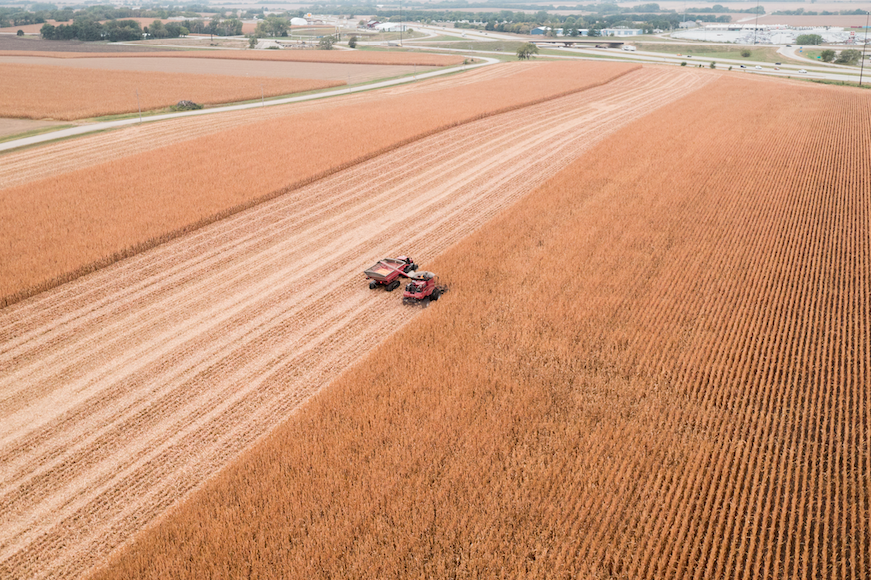Apr 10, 2025
Maximize Corn Yield Potential & Minimize Stress with Post-emergence Weed Control
Kathryn Kamman
Market Development Agronomist

As a corn grower, you know the vital role every stage of your crop’s development plays in determining yield potential. However, even with optimal planting conditions, the right seed, proper fertilization and favorable weather, one critical factor can undermine your corn’s potential: weed competition. Effective weed management, including post-emergence applications, helps ensure your corn thrives and reaches its full yield potential.
Dynamic spring weather means pre-emergence herbicide applications aren’t always possible. If you miss a pre-emergence application or didn’t plan one at all, it’s crucial to make your post-emergence application as soon as possible. Weeds grow fast — some aggressive species, like Palmer amaranth and waterhemp, can grow multiple inches a day. Applying herbicides when weeds are small (generally under 3-4 inches tall) is one of the best ways to ensure the herbicide can do its job effectively. If weeds get too large, they become more difficult to control, requiring higher herbicide rates or more costly mixes.
It is also important to consider your corn's growth stage when applying post-emergence herbicides. Many herbicides have specific restrictions based on the corn’s growth stage (often measured by leaf collar stages) or plant height. Applying beyond the recommended stage can reduce herbicide performance or injure the crop. Follow herbicide label instructions and proactively schedule applications before the corn reaches these critical growth stages for best results.
When choosing your herbicide mix, consider your field's weed species and densities. In areas with high weed pressure, you may need to apply a higher herbicide rate or incorporate additional modes of action to ensure thorough control. Adding post-emergence herbicides with residual control can help prevent new weed emergence as the crop develops. This is especially critical for managing weeds with delayed emergence patterns, such as waterhemp.
On the other hand, in hot and dry conditions, the weed’s waxy cuticle becomes thicker, making it more difficult for herbicides to penetrate the plant’s leaves. Adding oil-based adjuvants to the tank can help herbicides penetrate the waxy layer and improve weed control effectiveness in these conditions.
When applying post-emergence herbicides, consider adding a drift reduction agent to ensure herbicide droplets stay on target. This is especially important when using herbicides like dicamba, which have the potential to drift and cause damage to neighboring fields.
AMS water conditioners are recommended for preventing herbicide tie-up when using weak acid herbicides, including glyphosate, glufosinate, 2,4-D amine, clethodim or PPO inhibitors.
As corn reaches the V3 growth stage, it transitions from relying on seed reserves and seminal roots for energy and water to pulling nutrients from the soil with the nodal root system. This is an excellent opportunity to consider adding micronutrients, such as zinc, manganese and boron, into your herbicide mix.
Contact your local agronomic advisor or CROPLAN retailer for more post-emergence weed management tips.
1 Nader Soltani, Christy Shropshire, Peter H. Sikkema "Impact of delayed postemergence herbicide application on corn yield based on weed height, days after emergence, accumulated crop heat units, and corn growth stage," Weed Technology, 36(2), 283-288, (27 January 2022)
All photos are either the property of WinField United or used with permission.
© 2025 WinField United. Important: Before use always read and follow label instructions. Crop performance is dependent on several factors many of which are beyond the control of WinField United, including without limitation, soil type, pest pressures, agronomic practices and weather conditions. Growers are encouraged to consider data from multiple locations, over multiple years and to be mindful of how such agronomic conditions could impact results. CROPLAN and WinField are trademarks of WinField United.
Why Post-emergence Weed Control in Corn Matters
While every crop is unique, corn tends to be less competitive with weeds than other crops like soybeans. Corn plants don’t have the same ability to adjust to weed competition by changing their growth patterns. For example, soybeans can sense nearby weeds and adapt by growing up instead of out to compensate for competition. Corn, however, doesn’t have this flexibility; it won’t alter its growth if it senses a heavy weed presence. Instead, it might even reduce the number of kernel rows around each ear, limiting its potential. This is why controlling weeds early — especially before the critical V5-V7 growth stages — is one essential part of maximizing yield potential.Herbicide Application Timing for Postemergence Weed Control in Corn
Post-emergence applications are a critical part of managing weeds that emerge after planting or in the absence of a pre-emergence herbicide application. Timing is a key factor in the effectiveness of post-emergence herbicides. Studies have shown that in low-weed-density conditions, waiting 27 days after emergence (DAE) for the initial post-emergence herbicide application led to a 5% yield reduction in corn. When weed density was higher, yield was reduced by 5% in just 11 DAE with no post-emergence herbicide application.1Dynamic spring weather means pre-emergence herbicide applications aren’t always possible. If you miss a pre-emergence application or didn’t plan one at all, it’s crucial to make your post-emergence application as soon as possible. Weeds grow fast — some aggressive species, like Palmer amaranth and waterhemp, can grow multiple inches a day. Applying herbicides when weeds are small (generally under 3-4 inches tall) is one of the best ways to ensure the herbicide can do its job effectively. If weeds get too large, they become more difficult to control, requiring higher herbicide rates or more costly mixes.
It is also important to consider your corn's growth stage when applying post-emergence herbicides. Many herbicides have specific restrictions based on the corn’s growth stage (often measured by leaf collar stages) or plant height. Applying beyond the recommended stage can reduce herbicide performance or injure the crop. Follow herbicide label instructions and proactively schedule applications before the corn reaches these critical growth stages for best results.
Herbicide Selection: Mixes, Modes of Action and Residual Control
Choosing the right herbicide mix is another critical aspect of post-emergence weed control. Ideally, your post-emergence application should control a broad weed spectrum, targeting both the weeds that are actively growing and those that have not yet emerged. Pre-mixed herbicides offer a convenient solution by combining multiple modes of action, which can help delay herbicide resistance.When choosing your herbicide mix, consider your field's weed species and densities. In areas with high weed pressure, you may need to apply a higher herbicide rate or incorporate additional modes of action to ensure thorough control. Adding post-emergence herbicides with residual control can help prevent new weed emergence as the crop develops. This is especially critical for managing weeds with delayed emergence patterns, such as waterhemp.
Tank Mix Partners for Post-emergence Weed Control
Effective post-emergence weed control depends not only on the herbicide mix but also on environmental conditions. Corn growth is slower under cool, wet conditions, which can affect herbicide performance. Cold, wet weather reduces the metabolic rate of corn, which can increase the risk of herbicide injury, especially with products like HPPD inhibitors. If you apply herbicides in cooler conditions, monitor the crop closely for potential crop injury symptoms, such as whitening or bleaching of the corn leaves.On the other hand, in hot and dry conditions, the weed’s waxy cuticle becomes thicker, making it more difficult for herbicides to penetrate the plant’s leaves. Adding oil-based adjuvants to the tank can help herbicides penetrate the waxy layer and improve weed control effectiveness in these conditions.
When applying post-emergence herbicides, consider adding a drift reduction agent to ensure herbicide droplets stay on target. This is especially important when using herbicides like dicamba, which have the potential to drift and cause damage to neighboring fields.
AMS water conditioners are recommended for preventing herbicide tie-up when using weak acid herbicides, including glyphosate, glufosinate, 2,4-D amine, clethodim or PPO inhibitors.
As corn reaches the V3 growth stage, it transitions from relying on seed reserves and seminal roots for energy and water to pulling nutrients from the soil with the nodal root system. This is an excellent opportunity to consider adding micronutrients, such as zinc, manganese and boron, into your herbicide mix.
Start Early for a Strong Season
Post-emergence weed control in corn is one critical piece for maximizing yield potential and ensuring corn plants aren’t stressed by weed competition. Optimizing your post-emergence application isn’t just about the herbicide; it’s about a holistic approach that includes careful attention to timing and conditions and performance-enhancing tank-mix partners like micronutrients and adjuvants. With thoughtful management, a solid weed control program can pave the way for a healthy, potential high-yielding corn crop.Contact your local agronomic advisor or CROPLAN retailer for more post-emergence weed management tips.
1 Nader Soltani, Christy Shropshire, Peter H. Sikkema "Impact of delayed postemergence herbicide application on corn yield based on weed height, days after emergence, accumulated crop heat units, and corn growth stage," Weed Technology, 36(2), 283-288, (27 January 2022)
All photos are either the property of WinField United or used with permission.
© 2025 WinField United. Important: Before use always read and follow label instructions. Crop performance is dependent on several factors many of which are beyond the control of WinField United, including without limitation, soil type, pest pressures, agronomic practices and weather conditions. Growers are encouraged to consider data from multiple locations, over multiple years and to be mindful of how such agronomic conditions could impact results. CROPLAN and WinField are trademarks of WinField United.
IF YOU LOVE OUR INSIGHT, YOU’LL LOVE OUR ROI POTENTIAL
Every successful harvest starts with a seed. It just can't end there. Choose which high-performing seed products you’ll start with this season.






